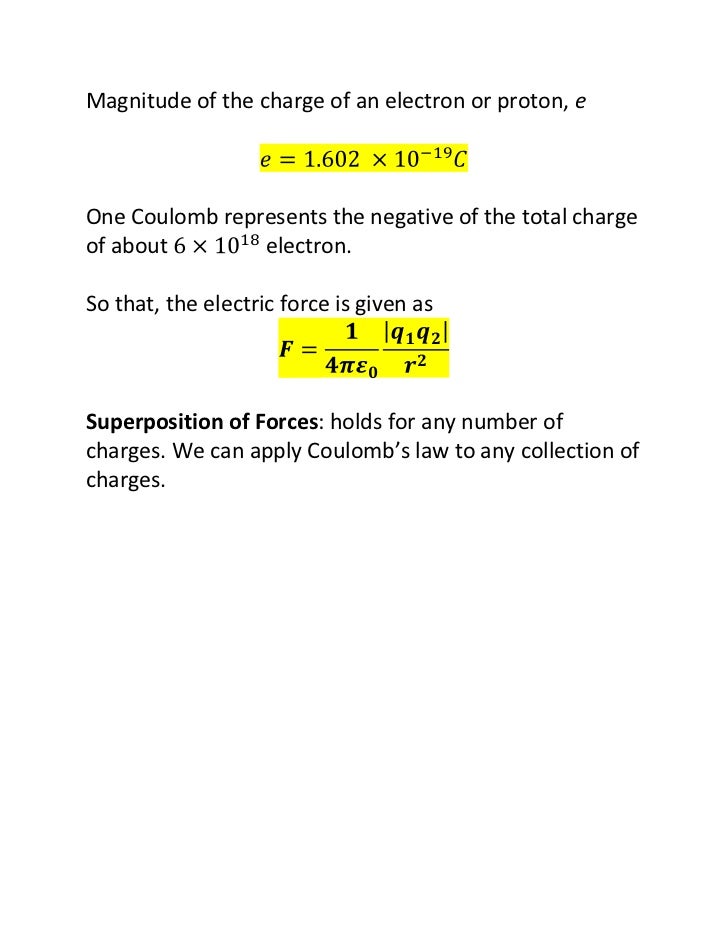
Know the value of Q is given to us and q is equal to 1 tulam therefore we have one coulomb is equal to the number of protons capital and X the charge of proton which is 1.6 into 10 to the power minus 19 coulomb so using this formula we can find the value of the number of protons capital which is equal to 1 coolum / 1.6 into 10 to the power minus 19 coulomb therefore number of protons which produce a charge of one column denoted as capital and is equal to 6.25 into 10 to the power 8 300 6. 1e = 1.602 x 10 -19 Coulombs, so the charge of a hydrogen nucleus is +1e and the charge of a helium nucleus is +2e.How many protons will constitutes a charge of one coulomb so we need to find a number of protons which will produce a charge of one coulomb so we know that the charge of proton is equal to 1.6 into 10 ki power minus 19 coulomb halogenated as small p and this has a positive sign in case of electron the charge magnitude was same but it had a negative sign here so if there are n protons capital and protons than the total charge Q will be equal to the total number of protons which is capital and multiplied by the charge of proton denoted as small p What about an oxygen nucleus? Hint: oxygen is atomic number 8.Īs a note, charge may also be expressed in elementary charge units (e). Electrons carry a charge of negative one electron unit, and protons a charge of positive one. The total charge of a helium nucleus is 2 x 1.602 x 10 -19 Coulombs = 3.204 x 10 -19 Coulombs. Electric charge is a fundamental property of matter. Atomic number 2 is helium, with a nucleus containing two protons and two neutrons. The total charge of all the protons in the hydrogen nucleus is given by 1 x 1.602 x 10 -19 Coulombs.

As you see, one coulomb is about 6 billion billion elementary charges. Williams (1938) has found that the fine structure of the H line in the spectrum of the hydrogen atom is not quite in agreement with. A hydrogen atom, for example, has atomic number 1, meaning its nucleus contains one proton (sometimes accompanied by a neutron in deuterium, or heavy hydrogen, but neutrons do not carry a charge-they just contribute mass), and the atom remains charge neutral when a single electron orbits the nucleus. We say the electron charge is negative (-), while the proton. Thus, one coulomb is the charge of approximately 6 241 509 074 460 762 607.776 elementary charges, where the number is the reciprocal of 1.602 176 634 × 10 19 C. In fact, the number of protons in the atomic nucleus defines the type of atom. a multiple of the electron or proton charge: proton charge: e1.602 x 10-19 Coulombs electron charge: e-1.602 x 10-19 Coulombs. The number of protons contained in the atomic nucleus is different for each chemical element. This proton, initially at rest, falls through a voltage difference of 100. An atomic nucleus is composed of protons and neutrons, and the nucleus is orbited by electrons.Ī single electron has a charge of -1.602 x 10 -19 Coulombs, a negative charge which exactly cancels the positive charge of one proton. Question: -19 (A proton has a charge of 1.6x10 coulombs and a mass of 1.7x10-27 kg.


e magnitude of the charge of the electron in coulombs 1.602 10-19 coulombs. What is the total charge or strength of all the protons in the nucleus of an atom?Ī single proton has a charge of +1.602 x 10 -19 Coulombs. The charge to mass ratio of an electron is denoted by the following formula : e m 1.758820 × 1011 C/kg Where in, m mass of electron in kg 9.10938356 × 10-31 kilograms.


 0 kommentar(er)
0 kommentar(er)
